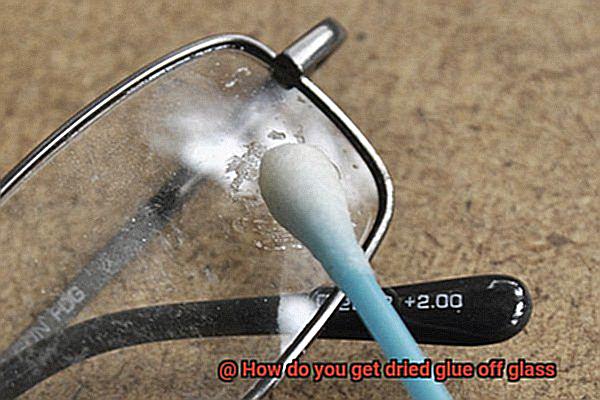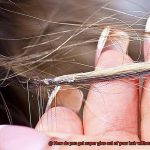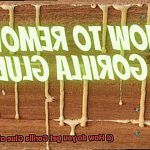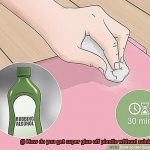Imagine this: you’ve just finished an artsy project or a home renovation, only to find your glass surface covered in clingy dried glue. Ugh, talk about annoying. But fear not, my friend, because you’ve stumbled upon the exact guide that will free your glass from this sticky situation.
In this blog post, we’ll explore some tried-and-true methods to effectively remove dried glue from glass and bring back its sparkling transparency. Whether it’s an adhesive blob from a DIY disaster or the residue left behind by a stubborn label, we’ve got your back.
Now, before we dive into the nitty-gritty of glue removal, let’s address something important. When it comes to glass, patience is key. Rushing through the process might result in scratches or damage. So take a deep breath and approach this task with a steady hand and some tender loving care.
Alright then, no more wasting time. Let’s jump into the world of glass and bid farewell to that unsightly dried glue.
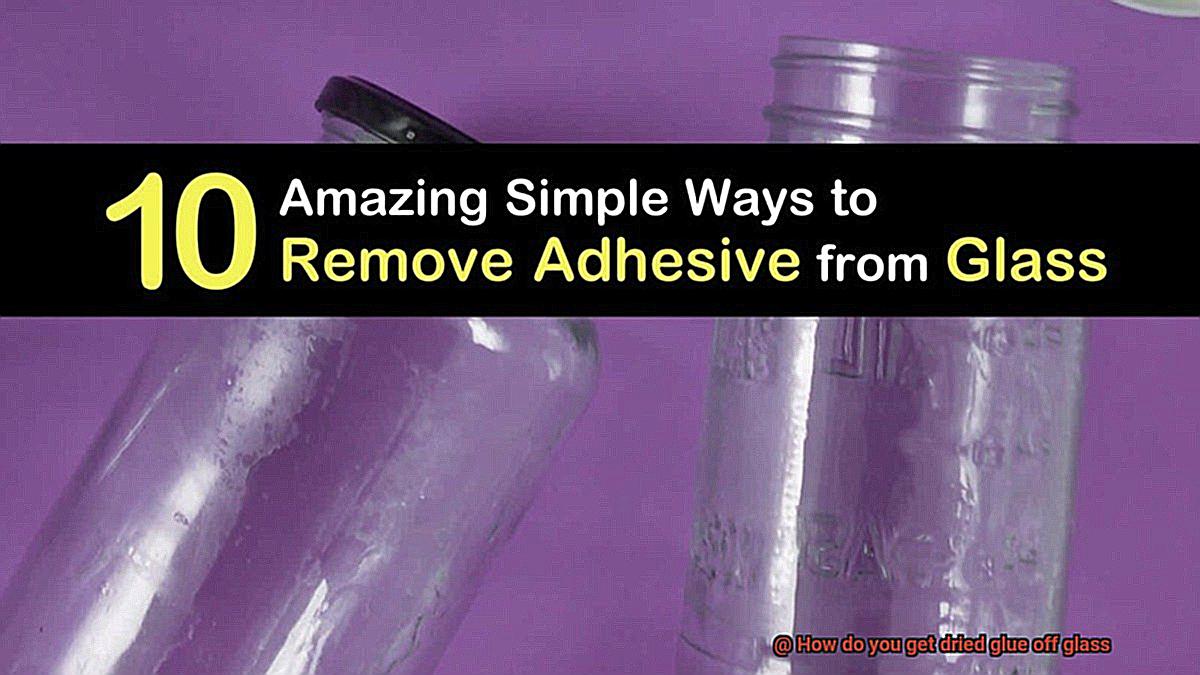
Method 1: Soaking and Scrape Technique
Contents
- 0.1 Method 1: Soaking and Scrape Technique
- 0.2 Method 2: Vinegar and Lemon Juice Magic
- 0.3 Method 3: Trusty Rubbing Alcohol
- 0.4 Method 4: Commercial Solvents – The Last Resort
- 1 Common Methods for Removing Dried Glue from Glass
- 2 Scraping Off Dried Glue from Glass
- 3 Preventing Glue From Adhering to Glass Surfaces
- 4 Choosing the Right Method for Your Needs
- 5 Considerations When Using Commercial Adhesive Removers
- 6 How to Safely Scrape Away Dried Glue from Glass
- 7 Benefits of Taking Preventive Measures Against Dried Glue on Glass Surfaces
- 8 Conclusion
Our first method combines the power of soaking and scraping. You’ll need warm soapy water, everyday household items, and a bit of elbow grease.
Method 2: Vinegar and Lemon Juice Magic
For our second method, we’ll tap into the natural acidity of vinegar and lemon juice. These household heroes have adhesive-dissolving superpowers that work wonders on dried glue stuck on glass surfaces.
Method 3: Trusty Rubbing Alcohol
Need an affordable yet effective solution? Method three calls for everyone’s versatile friend: rubbing alcohol. Discover how this potent liquid dissolves dried glue like nobody’s business, leaving your glass residue-free and gleaming.
Method 4: Commercial Solvents – The Last Resort
When all else fails or you’re dealing with a stubborn glue stain, it’s time to bring out the big guns: commercial solvents designed specifically for adhesive residues on glass. But be careful, my friend. These powerful chemicals should be used sparingly and in well-ventilated areas.
Common Methods for Removing Dried Glue from Glass
Fear not, as we have the perfect guide to help you remove that stubborn adhesive. In this blog post, we will explore the most common and effective methods, including harnessing the power of heat, using solvents and adhesive removers, relying on natural solutions like vinegar and rubbing alcohol, and the classic warm soapy water method.
Method 1: Harness the Power of Heat
Direct a hairdryer or heat gun onto the dried glue, watching as it softens before your eyes. Gently scrape it off with a plastic scraper or an old credit card.
Method 2: Solvents and Adhesive Removers
Commercial products designed for glue removal break down adhesive properties. Follow instructions carefully and test on a small area first to avoid damage.
Method 3: Vinegar, a Natural Solution
Soak a cloth or paper towel in vinegar and place it over the dried glue. Let it sit for a few minutes to dissolve the glue. Gently scrub with a soft-bristled brush or sponge.
Method 4: Rubbing Alcohol to the Rescue
Soak a cotton ball or cloth in rubbing alcohol and apply it directly to the glue. Give it a few minutes to break down the adhesive properties before gently rubbing with a cloth or sponge.
Method 5: Warm Soapy Water, a Classic
Soak the affected area with warm soapy water, let it sit, then gently scrub with a cloth or sponge. Rinse with clean water and dry with a soft cloth.
Scraping Off Dried Glue from Glass
Scraping off dried glue from glass can be a frustrating task, but fear not. With the right techniques and tools, you can remove that pesky adhesive and restore your glass to its original shine. So let’s dive in and get started.
- Gather your tools: Before you begin, make sure you have the right tools for the job. A razor blade scraper or a plastic putty knife are perfect for scraping off dried glue from glass. Choose whichever you feel comfortable using, but handle a razor blade scraper with caution to avoid accidents or damage.
- Soften the glue: To make your scraping job easier, soften the dried glue by applying heat. Use a hairdryer on its highest heat setting and direct the hot air towards the glue for a few minutes. Watch as it loosens up those adhesive properties.
- Start scraping: Now comes the satisfying part – start scraping off that softened glue. Gently slide your chosen tool under an edge of the dried glue and begin scraping it off in small sections. Be patient and avoid applying too much pressure to prevent scratching or damaging the glass.
- Adhesive remover to the rescue: If the glue is stubborn, don’t worry – we’ve got a secret weapon. Grab a commercial adhesive remover specifically designed for glass surfaces. Apply a small amount onto a clean cloth and gently rub it over the dried glue. Let it sit for a few minutes to penetrate the glue before attempting to scrape it off again.
- Soak it up: Sometimes, a little soaking is all you need. Fill a bowl or sink with warm soapy water and let the glued area soak for about 15-20 minutes. This will help soften the glue even further, making it easier to scrape off. After soaking, use your trusty tool to gently lift off the softened glue from the glass surface.
- The finishing touch: Congratulations, you’ve successfully scraped off the dried glue. Now it’s time to wipe away any remaining residue. Grab a clean cloth or sponge dampened with warm water and give the glass surface a good wipe down. For stubborn residue, try using a mild glass cleaner or vinegar diluted with water for that extra cleaning power.
Preventing Glue From Adhering to Glass Surfaces
We’ve all been there – attempting a DIY project or fixing something with glue, only to end up with a sticky mess on our glass surfaces. But fear not. In this comprehensive guide, we will explore the best ways to prevent glue from sticking to glass surfaces, ensuring hassle-free projects and easy cleanups.
Clean the Glass Surface:
Before applying any glue, it’s crucial to ensure that the glass surface is pristine. Use a damp cloth or a specialized glass cleaner to wipe away any dust, dirt, or debris. By starting with a clean slate, you create an optimal environment for preventing glue adhesion.
Apply a Barrier or Protective Covering:
Want to keep glue at bay? Create a protective shield between the adhesive and the glass surface. Apply a thin layer of petroleum jelly or cooking oil onto the glass, acting as a temporary barrier that prevents the glue from bonding permanently. This also aids in easy removal of excess glue later on.
Use Masking Tape or Painter’s Tape:
To safeguard the edges of the glass from accidental spills or drips, employ masking tape or painter’s tape around the perimeter. This simple step ensures that the glue stays where it’s supposed to and makes cleanup a breeze.
Consider Glue Type:
Different glues have varying adhesive properties towards glass surfaces. Hot glue and epoxy are notorious for their strong bond with glass. If using these types of glues, consider using specialized glue release agents or adhesive removers designed specifically for them. Applying these products before the glue dries weakens its grip on the glass, simplifying removal.
Explore Non-Permanent Alternatives:
For small objects or delicate surfaces, consider non-permanent adhesive alternatives such as double-sided tape or removable adhesive putty. These options provide temporary adhesion without leaving behind residue or causing damage to the glass surface. They can be easily removed when the project is complete.
Choosing the Right Method for Your Needs
There is a method to remove dried glue from glass and restore its pristine beauty. But how do you choose the right method for your needs? Let’s break it down:
- Consider the type of glue: Different glues have different properties, so it’s essential to know what type of glue you’re dealing with. For example, hot glue can be easily removed with a heat gun or hairdryer, while super glue may require the use of solvents.
- Assess the size and thickness of the glue residue: The size and thickness of the glue residue will determine the best method for removal. A gentle solvent or natural remedy like vinegar may be sufficient for small, thin layers of glue. However, larger or thicker deposits may require heat or scraping techniques.
- Mind the fragility of the glass: Delicate glass surfaces can be easily damaged, so it’s crucial to choose a method that won’t harm or scratch the glass. Opt for gentle solutions like dish soap and warm water or vinegar when dealing with fragile glass.
Now that we’ve covered the basics, let’s explore some tried-and-true methods:
- Heat it up: Use a hairdryer or heat gun to warm the glue, making it easier to scrape off with a plastic card or scraper. Remember to exercise caution and avoid excessive heat that could damage the glass.
- Solvent power: Choose a solvent or adhesive remover specifically designed for glue removal. Follow the product instructions carefully and ensure compatibility with your glass type.
- Natural alternatives: Vinegar and nail polish remover (containing acetone) can work wonders on dried glue. Apply them to the affected area, let them sit for a few minutes, then gently scrub away the softened glue.
- Dish soap and warm water: Create a soapy solution, apply it to the glue, and let it sit for a few minutes. Gently scrub with a sponge or soft cloth, then rinse thoroughly.
Remember to test any method on a small, inconspicuous area before tackling the entire glue residue. Patience is key. Rushing or using excessive force can lead to unwanted scratches or damage.
Considerations When Using Commercial Adhesive Removers
Glass surfaces bring elegance to any space, but stubborn dried glue can be an eyesore. Thankfully, commercial adhesive removers are here to save the day. However, before diving into glue removal, it’s crucial to consider a few key factors. This blog post explores the essential considerations for safely and effectively using commercial adhesive removers on glass surfaces.
Choosing the Right Product:
Not all adhesive removers are created equal. Opt for a product specifically formulated for glass surfaces to avoid potential damage or etching. Look for products that explicitly state their compatibility with glass.
Consider the Type of Glue:
Different adhesives require different approaches. Solvent-based removers are effective for super glue or epoxy adhesives, while water-based options work well for sticker or label residue. Knowing the type of glue you’re dealing with helps you choose the right product and method.
Testing is Key:
Before going all-in, perform a small test patch in an inconspicuous area. This ensures that the adhesive remover won’t cause any damage or discoloration on your delicate glass surface.
Follow Manufacturer’s Instructions:
Don’t rush. Follow the provided instructions meticulously. Applying the recommended amount of adhesive remover and allowing it to sit for the specified duration yields the best results without risking damage to your glass surface.
Safety First:
Work in a well-ventilated area and wear protective gloves and eyewear to prioritize safety when handling any chemical product. Be cautious with skin and eye contact. If accidental exposure occurs, rinse thoroughly with water and seek medical attention if needed.
The Final Touch:
Once the dried glue is successfully removed, give your glass surface some extra TLC. Clean the area with a mild glass cleaner to remove any residue from the adhesive remover, restoring its clarity and shine.
How to Safely Scrape Away Dried Glue from Glass
We’ve all experienced the frustration of dried glue on glass surfaces. But fear not. With a little know-how and the right tools, you can safely scrape away dried glue from glass without causing any damage. In this guide, we’ll walk you through the process step by step, ensuring your glass surfaces are left clean and unharmed.
Gather the Necessary Tools:
Before you begin, make sure you have the right tools on hand. Opt for a plastic scraper or a plastic putty knife, as metal tools can scratch or damage the glass. You’ll also need a spray bottle filled with warm water and a few drops of mild dish soap to help loosen the glue.
Scraping Tools: Plastic scraper or plastic putty knife
Loosening Agent: Warm water and mild dish soap
Spray and Soak:
Spray the warm soapy water onto the dried glue and let it sit for a few minutes. This will soften the glue, making it easier to remove without causing any harm to the glass.
Gentle Scraping:
Take the plastic scraper or putty knife and gently start scraping away the softened glue. Remember to use light pressure and work slowly to avoid accidental damage. If the glue is stubborn, repeat the spraying process and let it sit for a little longer before attempting to scrape again.
Watch Your Angle:
Keep the blade of your scraper at an angle parallel to the glass surface. This helps prevent scratches or gouges. Adjust your angle or direction as you work through different areas or layers of dried glue.
Stubborn Remnants:
If there are small remnants of glue left behind after scraping, dampen a soft cloth with warm soapy water and gently rub in circular motions. This should lift off any remaining residue without causing damage.
Alternative Methods:
If scraping and rubbing don’t completely remove all traces of dried glue, there are alternative methods to consider. You can try using a commercial adhesive remover designed for glass surfaces. Follow the instructions carefully and test on a small area first. Another option is using household items like vinegar or rubbing alcohol. Soak a clean cloth in either liquid and apply it to the dried glue, then gently scrape away.
Benefits of Taking Preventive Measures Against Dried Glue on Glass Surfaces
We’ve all been there, struggling to remove those unsightly residues that make our glass look dirty and dull. But what if there was a way to prevent glue from drying on your glass in the first place? Taking preventive measures against dried glue on glass surfaces can save you time, effort, and money in the long run. Let’s delve into the benefits in more detail:
- Preserving Aesthetic Appeal: Nobody wants their beautiful glass surfaces to look dirty or unattractive. By preventing glue from drying on the surface, you can preserve the original shine and clarity of your glass. Imagine gazing through crystal-clear windows or showcasing your glassware without any blemishes.
- Prolonging Lifespan: Removing dried glue can be a tricky task that often leads to scratches or even cracks on the glass surface. By preventing glue from drying in the first place, you can avoid damaging your precious glass during removal. This helps to extend the lifespan of your glass, ensuring it stays in pristine condition for years to come.
- Ensuring Safety: Glass is commonly used in windows and doors where visibility is paramount. Dried glue residues can obstruct your view, posing a safety hazard, especially when driving or operating machinery. Taking preventive measures ensures that your visibility remains unimpeded and accidents are minimized. Clear vision equals enhanced safety.
- Saving Time and Effort: Removing dried glue from glass surfaces can be a labor-intensive task that requires patience and precision. By preventing glue from drying on the surface, you can save yourself hours of scrubbing and scraping later on. Time saved means more time for activities you enjoy.
- Avoiding Additional Expenses: If left untreated for too long, glue residues become more difficult to remove and may require specialized cleaning products or professional services. By simply preventing glue from drying on your glass, you can avoid these additional expenses. Protecting your glass surfaces now saves you money in the long run.
oerkyhvuFQw” >
Also Read: How to Remove Glue From Mirror?
Conclusion
Removing dried glue from glass can be a pesky task, but fear not.
There are several effective methods you can try. One option is to use acetone, a powerful solvent that breaks down the adhesive properties of the glue.
Simply soak a cotton ball in acetone and gently rub it on the affected area until the glue starts to dissolve. Another alternative is to employ white vinegar, which acts as a natural adhesive remover.
Just apply some vinegar onto a cloth or sponge and scrub away at the dried glue until it loosens up. For tougher glue stains, you can rely on the trusty combination of baking soda and water.
Create a paste-like mixture by mixing these two ingredients and apply it directly onto the glue. Let it sit for a few minutes before wiping it off with a damp cloth.
Remember to proceed with caution to avoid scratching the glass surface.

